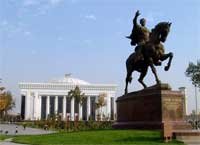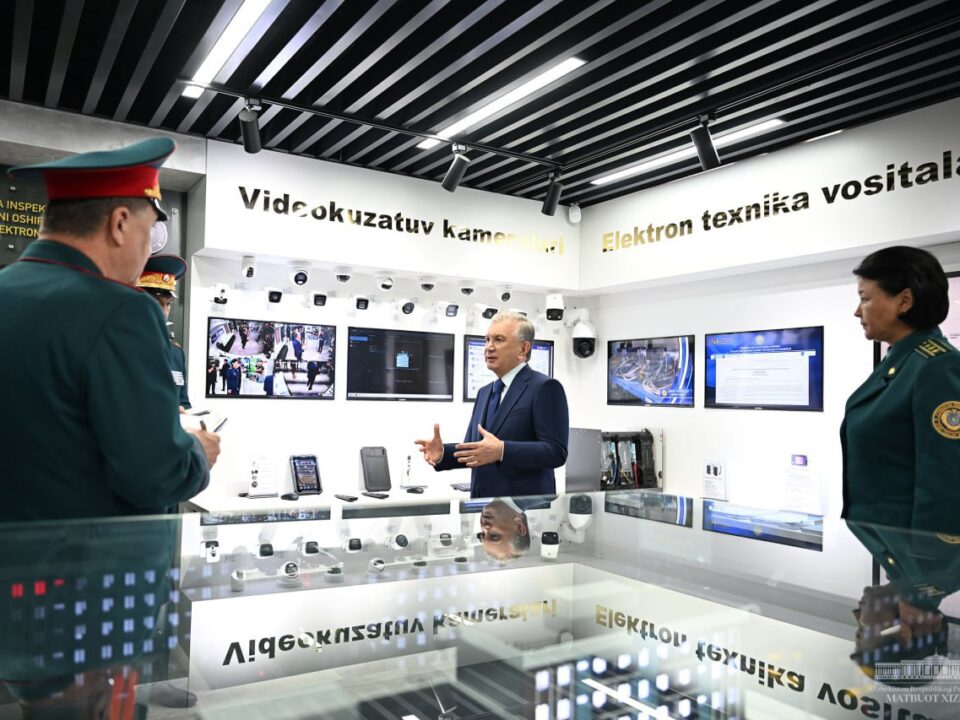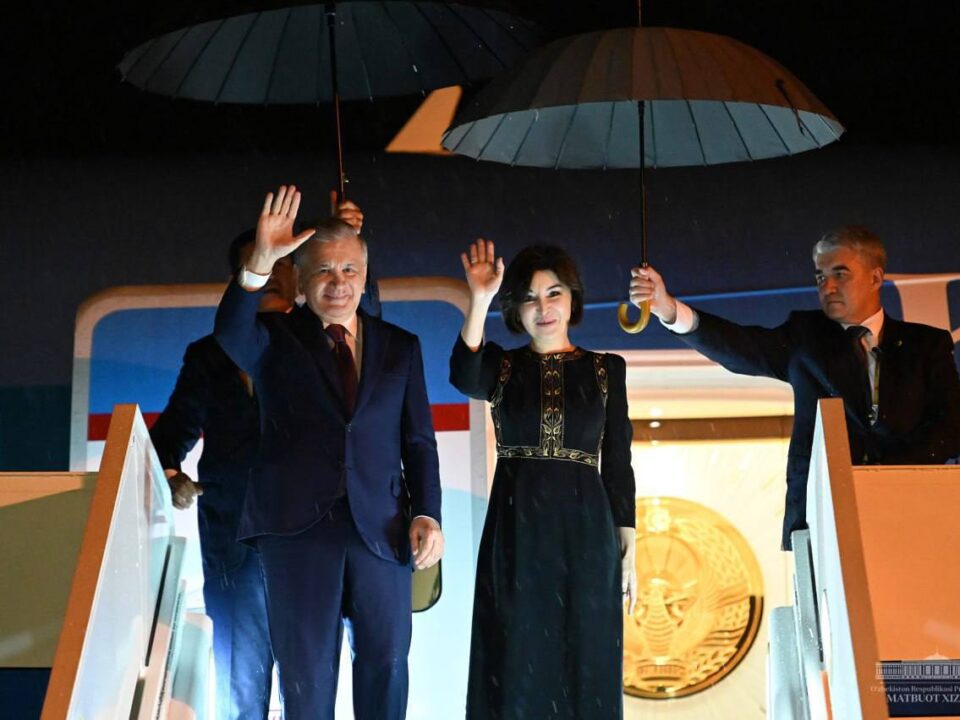Presidential election in Uzbekistan
By Rashmi Doraiswamy
Professor at the Academy of International Studies, Jamia Millia Islamia, New Delhi
The Navroz celebrations this year spilled over to the political festival of the Presidential elections in Uzbekistan. T h e international observers were treated to the great music of Olmas Saidjonov, Guksanam Mamazoitova, Munojat Yolchieva, traditional dances and food. Sumailak, the special wheatgrass sweet made during Navroz, that is cooked over slow fire for more than twenty four hours, was being made over large fires in huge pots everywhere and was being served up along with the famous Uzbek plov (pulao), the rich variety of breads and other sweets.
Uzbekistan became independent in 1991 after the fall of the Soviet Union. The Oliy Majlis, the Supreme Assembly succeeded the Supreme Soviet and was unicameral till 2005, when it became bicameral, consisting of the Legislative Chamber and the Senate. The elections to the Parliament were held in two rounds, once on 21 December 2014 and the next on 4 January 2015. The Liberal Democratic Party won the largest number of seats in these elections. According to the Constitutional Law on Presidential Elections passed in March 2012 by the Senate, the Presidential elections have to be held ninety days after the Parliamentary elections. There were four parties in the fray in the Presidential elections of the Republic of Uzbekistan held on 29 March 2015. Nariman Umarov was the candidate of the Adolat Social Democratic Party. Umarov’s programme stressed transparency in governance, social justice, empowerment of women, vocational education, and the need to focus on renewable energy resources. Hatamjon Ketmonov represented the People’s Democratic Party of Uzbekistan. The party, in its election manifesto, emphasised employment, the social protection of low income families, access to high quality medical care at affordable prices, and the need for a democratic state and open civil society. Akmal Saidov was the candidate from the Milliy Tiklanish Democratic Party of Uzbekistan and the agenda of his party included strengthening the mahalla system, the preservation and enhancement of national heritage and the democratization of the judicial sector. Milliy Tiklanish also insisted on economic measures to ensure production and distribution of high quality goods, support to the tourism industry, the need to improve living standards, to develop information and communications technologies and stressed the objective of foreign policy to guard against threats to security and stability in the region. Akmal Saidov, along with President Karimov, were the two candidates who had fought elections in 2007 as well for the post of President. In 2007 there was a woman candidate in the presidential elections, Diloram Toshmuhammadova.
The ‘Uzbek Model’
The Liberal Democratic Party had President Karimov as its candidate. President Islam Karimov’s programme was a detailed one validating the evolutionary path of independent development called the ‘Uzbek model’ that had been followed after Independence. This had led to the growth rate of the GDP for the past ten years of over 8% and per capita income that has multiplied by an average of 8%. The manifesto of the party focused on making the economy really competitive, on diversification of industry, ensuring complete freedom in the development of private property, agricultural reform and employment, on improving the quality of life of the population and on environmental problems and limited water and land resources. The foreign policy of the country was to aim at friendly relations to strengthen mutually beneficial cooperation with neighbours. The manifesto also stated that the country would not accede to pressure by blocs, to the stationing of foreign military bases and to the sending of Uzbek troops abroad.
The Central Election Commission of the Republic of Uzbekistan, which conducted the elections, was responsible for ensuring no violations occurred and that all candidates got equal opportunity to meet the voters. Early voting for pilgrims or those outside the country began ten days in advance and ended one day before theelections on 29th March. Each party was allowed 900 minutes of airtime, 10 pages of print publicity on the national media and 180 minutes of local airtime, and 5 pages of print in the local media.
International Observers
Over 300 international observers, along with observers from the CIS countries and representatives of international organisations such as the OSCE, OIC, SCO and the Association of World Election Commissions were invited by the CEC. There were more than 180 representatives from foreign media and 600 Uzbek media personnel to cover the elections.
I visited polling centres that were located in educational institutions in Tashkent. The schools and university buildings bore a look of festivity. Every polling centre had displayed the list of voters (the maximum in any centre was around 3000) along with all the material published by the Central Election Commission. Each party had its observers at the polling stations to keep an eye on the proceedings. The voter turn-out was large and people started coming in very early on the Sunday morning to cast their vote. The elections in Uzbekistan are unique because it is probably the only country in the world where each polling centre has a ‘Mother and Child’ room, where voters can leave their children while they vote. These rooms were filled with toys, with cartoon films, with paper and crayons and games. Supervisors for this room were also present to look after the children. In one school where Chinese was taught, the room was done up with Chinese fans and lanterns! Each polling centre also had a medical aid room with a doctor and nurse to attend to voters who may take ill. The consensus was that polling was conducted in an open and transparent manner. Those who could not come to the polling centre due to sickness or old age could request to vote at home. Each polling centre had smaller ballot boxes that could be carried for this purpose, and at several places I noticed that they had many ballots inside.
The centres I enjoyed the most were the lyceum where music is taught and the Conservatory. At the lyceum we were greeted by a student band playing music in the foyer. Inside, in the grand organ room, we were treated to classical western music played by the students who had won international awards in music and in the auditorium, we heard students play the traditional instruments of Uzbekistan, the setar, rubab and dombra!
At 8 pm, when voting came to an end, the sealed ballot boxes were opened and the ballot papers counted at the polling centre itself, under the watchful eyes of the observers from the political parties, as well as the international observers. Once the counting was done, the ballots were packed, sealed and sent to the central election office. Press briefings were held throughout the 29th (the day of polling) and on the 30th.
The focus during the elections this time was on the mahalla as a form of civil society organization.
If the West has NGOS, unions, professional organisations, faith-based associations, foundations and charitable organisations as part of the civil society networks, Uzbekistan has tapped its traditional community-based organization, the mahalla. It spans family, friend-networks, professional solidarity and is linked to a territory. It is historical community unit that serves as an informal mechanism to pass down values from one generation to another, to resolve disputes, distribute equitably resources that are scarce, and provide the support of the collective to an individual. This is the minimal unit of self-governance. The Law Government Agencies was first passed in 1993. This was followed in 2010 by President Karimov’s Further Deepening Reforms and the Formation of Civil Society in the Country’.
There are 9756 mahallas in Uzbekistan and they played an active role in the Presidential elections. First time voters were given support and advice on the carrying out of this important duty as a citizen.
Last year was celebrated as the ‘Year of the Healthy Child’ and the mahalla played an important role in the spread of awareness of this policy. From atop the tall TV Tower, which has a rotating restaurant on the top and has models of TV towers from many other parts of the world, the whole of Tashkent can be seen. What is evident is that there has been a lot of development and constructions in the city.
Two of the most impressive buildings built after Independence impressive White Mosque and the new National Library named after Alisher Navoi, the XV century poet. (There are several other such buildings such as the Museum dedicated to Timur, etc). The library was founded in 1870 in the Turkestan Region under the Russian Tsarist Empire and came to be named after the poet Navai in 1949, during Soviet times. This new building was built in 2011. It has a very large collection of books in over 65 languages and approximately 16000 old and rare books and manuscripts. It combines traditional architectural columns and the dome with modern glass structures and the latest technology, particularly in the trolleys that cart the books from the stacks to the reading rooms. A portrait of Alisher Navai, linguist, writer and poet in the Chagatai language, exhibition hall of the library.
A new exhibition of books from the library’s collection is mounted every month according to a theme. This current one was on miniatures. What was fascinating was the exhibition of cartoons in Uzbek language in the lobby with drawings from the humour journal ‘Mushtaram’. There was also an exhibition of books with their anniversary of publication being marked: 75 years of Sholokhov’s And Silent Flows the Don, 120 years of H G Wells, 90 years of Esenin’s poetry, 165 years of Alexander Dumas, anniversaries of Hemingway’s For Whom the Bell Tolls, Alexei Tolstoy”s Peter the First.
The Music Room had a collection of old long-playing records and books on music. There were two ‘sponsored’ rooms: one sponsored by the UN and the other by the government of South Korea. In the rare manuscripts and old books, the oldest book in the library from the XIII century by Abul Hasan al-Movardiy.
The huge Mustakillik Square has several monuments inside it and is surrounded by imposing government buildings in the distance, including those of the Parliament. In the park within the Square, there is the Monument to the Soldiers who lost their lives in the Second World War. So that the Fallen Soldier does not remain unknown, the government invited people to send in the names and addresses of family and friends who had died in the War and these were embossed in ‘metallic books’: lists of their names, area-wise, from all over Uzbekistan. The Square also has an imposing arch with the sculpture of the Birds of Peace and a monumental sculpture of Mother and child, under the map of Uzbekistan on a globe.
Families come to the Square for a stroll, especially with small children.
Given the steady development in the country and the desire of the people for stability and peace which will ensure continued progress, especially in the context of the turmoil in the extended neighbourhood, it is not surprising that people turned up in large numbers to vote and to return President Karimov to the post of President with an even greater majority in these elections.
Of the total of 20798052 voters, 18942349 people voted (amounting to 91. % of the voters), Islam Abduganievich Karimov polled 90.39% of votes, Saidov polled 3.8%, Ketmonov 2.92% and Umarov 2.5% of votes.




























